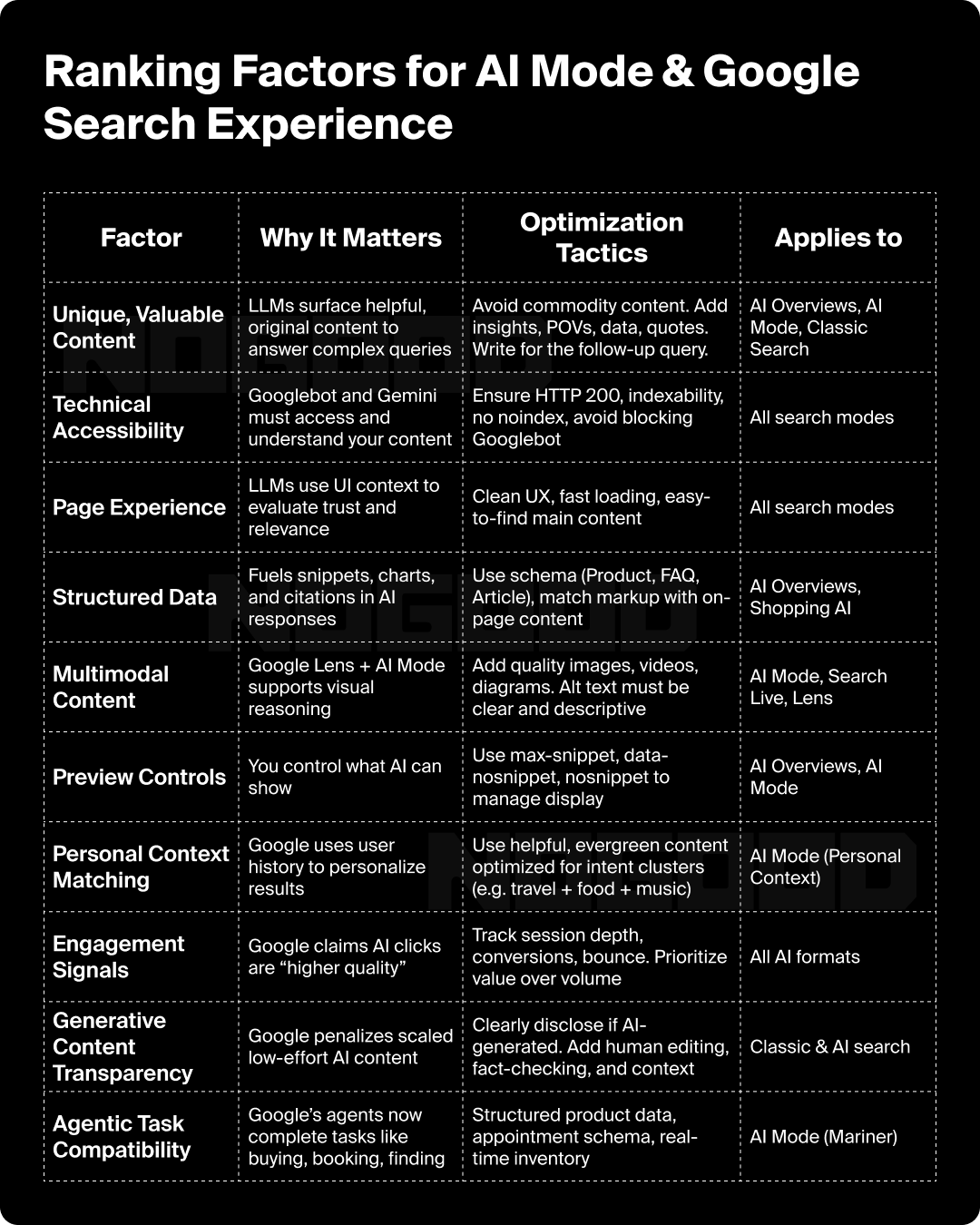Google’s search experience is fundamentally transforming into an AI-powered reasoning engine that synthesizes information, answers complex queries, and takes actions on behalf of users. With the rollout of AI Mode, AI Overviews, Deep Search, and agentic task handling, your brand’s discoverability is being shaped by LLMs and generative engines that cite, synthesize, and increasingly act on behalf of users.
This is your blueprint for staying visible, clickable, and trusted across Google’s evolving AI ecosystem.
Ranking Factors for AI Mode & Google Search Experience

How AI Mode Works
AI Mode is powered by a customized version of Gemini 2.5, Google’s most intelligent available model. This model is capable of thinking and reasoning through an in-depth thought process before responding, resulting in enhanced performance and improved accuracy.
- AI Overviews + AI Mode use query fan-out: They break a single question into many sub-queries to find the most relevant, high-quality information across the web.
- Deep Search can generate expert-level, cited reports, favoring multi-source, semantically rich pages.
- Real-time multimodal capabilities: AI Mode integrates live visual search through Project Astra, allowing users to have conversations about what they see using their camera.
Content Strategy for AI Overviews & Deep Search
Google’s shift to AI Overviews and Deep Search fundamentally changes how your content is discovered and cited. Instead of returning a list of links, Google is now using Gemini to interpret intent, break queries into subtasks, scan hundreds of sources, and synthesize a cohesive answer.
This changes your job from “get ranked” to “get cited.”
What Google AI is Optimizing For
- Relevance and specificity
- Originality and depth of insight
- Authoritativeness, especially from niche experts
- Semantic alignment with related subqueries
How to Optimize Your Content
Write for real human intent: Don’t just target keywords. Reverse-engineer full user prompts and sub-questions using forums like Reddit, Quora, and People Also Ask to understand how people phrase real questions.
Structure for skimming AND synthesis: Use subheadings, bullet points, summaries, and data boxes to make it easy for Google to extract meaningful text chunks.
Go deeper than summary-level advice: Offer frameworks, decision matrices, pricing breakdowns, firsthand experiences, expert quotes, or user-generated insights. Additionally, including expert quotes and firsthand experiences improves your brand authority and expertise.
Answer the follow-up question: If a user asks, “Is creatine good for runners?”, include the science behind it, usage tips, side effects, alternatives, and expert opinion. This way, you can cover both the explicit and the implicit user intents.
Create data-backed, expert-level content: AI Overviews are more likely to link to content with citations, named authors, data sources, and external references.
Technical AEO for AI Mode Retrieval
Technical accessibility is the price of admission. Googlebot and Gemini need to find, access, and interpret your content without friction.
Top 7 Must-Haves
- Pages return 200 status codes (avoid soft 404s, 3xx redirects, or errors)
- No robots.txt blocking Googlebot or Google-Extended
- Meta tags like
noindex,nosnippet, ordata-nosnippetare used intentionally - Consistent canonical tagging to prevent duplicate content conflicts
- Mobile-first design that loads fast and works across screen sizes
- Proper use of headers (
<h1>to<h3>) to reflect content hierarchy - Descriptive titles and meta descriptions that align with user intent and long-tail queries
Bonus Tips for AI performance:
- Semantically structured content with NLP-friendly phrasing
- Longer-tail topic pages that cover a full topic cluster rather than just a single keyword
- Embedded answers to FAQs, comparisons, and pros/cons to help LLMs extract structured information
Structured Data & Multimodal Optimization
AI Mode and Overviews rely heavily on structured data to surface and summarize rich content. As Google adds capabilities like visual live chat, virtual try-ons, and financial data graphs, structured data becomes essential.
Structured Data Best Practices
Structured data implementation provides search engines with the context they need to properly understand and showcase your content. Implement schema.org types that align with your specific business needs, including:
- Product markup for e-commerce sites,
- Service schema for professional offerings,
- Article markup for blog content,
- FAQPage schema for support sections,
- Event markup for upcoming activities,
- LocalBusiness for location-based services
- Recipe schema for food-related content etc.
Quality control is essential once you begin implementing structured data across your site. Validate every markup addition using Google’s Rich Results Test to ensure proper implementation, and maintain strict consistency between your schema content and what visitors actually see on the page. Mismatches can result in search engine trust penalties.
Enhance your credibility signals by including author, datePublished, and publisher information wherever applicable. These elements help establish authority and can positively impact how your content performs in search results.
Tips for Multimodal Search Optimization
- Use original images with descriptive, natural-language alt text
- Compress and size images for fast loading
- Add short-form video explainers or walkthroughs
- Upload video transcripts for better semantic extraction
- Keep Google Merchant Center product data and Business Profile details up-to-date and optimized
This matters more now that AI Mode includes Search Live, which lets users point their camera at an object or visual and ask live follow-up questions.
AI-Generated Content Guidelines & Trust Signals
Using AI to write content is not banned. But using AI to flood Google with thin, low-effort pages is grounds for a penalty under their scaled content abuse policy.
Follow These 4 Key Principles
- Don’t mass-publish similar pages that differ only by city/product/category name
- Add real human context and editing to every AI-assisted piece
- Disclose automation where relevant, such as:
- Author notes
- Image metadata (using IPTC DigitalSourceTypeTrainedAlgorithmicMedia)
- Page footers with transparency disclaimers
- Use generative AI to structure, not replace, human creativity. Think: first draft assistant, not auto-publisher.
Metadata and Markup Hygiene
Every page requires custom <title> and <meta description> tags that accurately represent its content and purpose. Your structured data should be descriptive and consistent across all implementations while staying compliant with search engine policies to avoid penalties.
Enhance your markup with additional context signals where relevant, including isAccessibleForFree, inLanguage, and contentLocation tags. These additional data points help search engines better understand and categorize your content for more precise targeting.
How to Measure Performance Beyond CTR
Clicks are a fading metric in the AI search era. Google says AI Overviews drive “higher-quality clicks,” but volume is down and continuing to decrease
Key Metrics
- Conversion rate (form fills, purchases, subscriptions)
- Session depth (pages per visit)
- Time on site and bounce rate
- Return visits and retention
- Lead quality, not just quantity
Tools
- GA4 + Looker Studio dashboards for engagement segmentation
- Heatmaps (Hotjar, Microsoft Clarity) to analyze content friction
- First-click vs. last-click attribution modeling to evaluate AI-driven journeys
- Server-side tagging to capture more reliable data, especially with AI agents acting on behalf of users
- AEO platforms like Goodie AI to monitor visibility, measure performance, and take actions across AI search platforms
Next-Level Tactics for Brand Visibility
AI Overviews and AI Mode pull from a wider range of sources than classic Search. Your brand’s presence across the entire web determines your visibility.
Become an Entity, Not Just a Website
Ensure you build consistent profiles across Wikipedia, Crunchbase, LinkedIn, GitHub, YouTube, and press articles. Using a well-rounded strategy mitigates the chances of incorrect information being sourced and improves visibility through presence. Connect identities through sameAs schema and keep your About Page structured, semantic, and detailed.
Use Semantic Saturation
Build strong associations between your brand and high-intent phrases by consistently positioning your brand name close to the terms that matter most to your business. Create comprehensive, glossary-style content that defines and explores the terminology you want to own within your industry space.
Structure your content using hub-and-spoke topic clusters that demonstrate your domain expertise to AI systems. This approach helps large language models understand the breadth and depth of your authority across interconnected topics, making you more likely to be referenced as a credible source.
Get Mentioned in Credible Sources
Expand your digital footprint through strategic outreach to high-authority blogs, industry publications, podcasts, and newsletters within your sector. Position yourself as a thought leader by contributing to guest articles or participating in expert roundups that showcase your expertise to new audiences.
Build citation momentum across platforms where professionals gather and share insights, including Quora discussions, relevant Reddit communities, LinkedIn thought leadership posts, and Substack publications. These mentions create the reference signals that AI systems use to assess credibility and authority.
Optimize for How People Ask, Not How They Search
Instead of optimizing for traditional keyword phrases, design landing pages that directly answer the conversational questions users actually ask AI systems.
Rather than targeting “CRM for small SaaS,” create content that responds to natural language queries like “What’s the best CRM for small SaaS startups in 2025?” Apply this same approach across different content types, such as creating pages that answer “How to get verified on Instagram without being famous” instead of targeting “Instagram verification,” or “Compare budget electric SUVs with over 300-mile range” rather than “electric SUV comparison.”
These natural language patterns reflect how users communicate with AI assistants and search for information in an increasingly conversational search environment.
Future-Proofing: Agentic Search & AI Actions
Google AI Mode is not just answering questions. It’s now doing things on behalf of users:
- Booking reservations
- Purchasing tickets
- Comparing SKUs
- Surfacing local availability and pricing
If You Want Your Business to Be Selected by AI Agents
Make sure to keep your Google Business Profile up-to-date. Ensure you use availability, price, and action structured data. Additional best practices to improve selectability are to integrate with booking and ticketing partners such as:
- Resy
- OpenTable
- Vagaro
- Ticketmaster
- StubHub
Lastly, to automate your process and simplify updates, use a public API or structured feeds so Google can access real-time inventory
Anticipate Changes in User and AI Agent Behavior
Prepare for the shift toward conversational commerce, where users make specific requests like “find me a black turtleneck under $50, size M, in stock near me” rather than browsing product categories.
Similarly, LLM-driven agents will handle complex, multi-step tasks such as “book the closest available dentist for Thursday 4 pm, under $150,” requiring businesses to structure their data and booking systems for AI accessibility.
We’re Already in the Future of Search
LLMs are shaping what users see, trust, and act on. To stay visible and drive organic growth, your content must be designed for humans AND for generative engines.
This means shifting from keyword targeting to intent mapping, prioritizing organic conversions over vanity traffic metrics, and creating structured, original, expert-level content that demonstrates clear authority. Treat technical SEO as your foundational layer while embracing structured data and multimedia formats that AI systems can easily parse and reference. Focus on deeper engagement metrics that reflect genuine user value, and prepare for a world where AI agents increasingly determine which brands get discovered and which get overlooked.
The rules of search are being rewritten, but the opportunity is enormous. The brands that adapt fastest, those who earn visibility through value, clarity, and semantic strength, will dominate the AI-first era of discovery.






